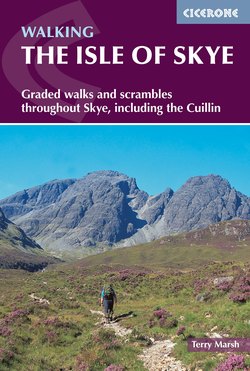Читать книгу The Isle of Skye - Terry Marsh - Страница 21
На сайте Литреса книга снята с продажи.
ОглавлениеSECTION 2 STRATH
The Cuillin from Elgol (Walk 2.17)
INTRODUCTION
Heading for Bla Bheinn
If you were to search for one area of Skye that contains a taste of everything you might find elsewhere, you need look no further than Strath. It is a unique area, with an unusual independence, neither North Skye nor South Skye, neither MacLeod territory nor MacDonald. This was MacKinnon country, sandwiched between the two frequently warring factions, and adept at keeping the peace with both – which is probably why the MacKinnons earned the uncomplimentary nickname ‘Two-Faced’.
Bounded on the north by Loch Sligachan and the south by Lochs Scavaig, Slapin and Eishort, Strath extends westwards from Broadford Bay as far as Glen Sligachan. Within this loch-probed sanctuary lies some of the most fascinating and widelyvaried walking ground on the Island, ranging from coastal exploration around the Strathaird peninsula and along the north shore of Loch Eishort, to the domed scree-heights of the Red Cuillin and the dark Cuillin Outliers, culminating in the single most attractive mountain on Skye, Bla Bheinn.
There is something for everyone here – whether intent on conquering mountains or merely exploring – ruined villages, stone circles, limestone caves, sandstone cliffs, prehistoric cairns, great glens, coastal geos, and a tremendous wealth of social and natural history.
Strath, too, seems to have been a major centre of religious importance since the earliest times, and there is evidence of both pagan and Christian religions throughout the entire region. Quite often you will find the remnants of the two religious traditions almost side by side – ruined churches standing close by stone circles – a clear suggestion that, although St Columba sought to convert the pagan people to Christianity, he was not so foolhardy as to demolish their sacred places.
The key to much of the area is the seemingly innocuous road that sets off Elgol-bound from the town of Broadford. The road first enters lovely Strath Suardal beneath the red hills of Beinn na Caillich, Beinn Dearg Mhór and Beinn Dearg Bheag. It all seems now to be a place of peace, flowing richly with the enchantment of the wild, heavy with the charm of the past, but this same glen was the source of immense and violent volcanic upheaval. On the opposite side of Loch Cill Chriosd you can still see the site of the main vent, now filled with coarse-grained material.
On a clear day, Strath Suardal is a place of great beauty, but wreathed in mist, it assumes an eerie air, and seems to support the claim that ‘The waste is haunted…by Ludag, a malignant goblin, that in the [18th century] used to be seen at dusk hopping with immense hops on its one leg – for unlike every other denizen of the supernatural world, it is not furnished with two – and that, enveloped in rags, and with fierce misery in its hollow eye, has dealt heavy blows, it is said, on the cheeks of benighted travellers’. Loch Cill Chriosd, too, is said to be haunted, by a terrible monster which laid waste to the land, and carried off and devoured women and children. Not until St Maelrhuba blessed the waters of the loch was the monster laid to rest, since when the loch waters are said to have held great healing powers.
As you journey down the road you encounter first, just at a bend, a green knoll that bears the name An Sithean. This means ‘fairy hill’, and here at night if you listen with an open mind, you may well hear the sounds of fairy music rising through the ground. Whether or not you believe in fairies, An Sithean gives you a good view of Coire-chatachan, the MacKinnon home twice visited by Johnson and Boswell during their visit to Skye in 1773, and a year earlier by Thomas Pennant.
Further into the glen you reach the ruined church of Cill Chriosd, ivy- and cotoneaster-clad, surrounded by a graveyard much older than the church, and which may date from prehistoric times. The church, the former parish church of Strath, evidently existed in the early 16th century, and probably during the late 15th, but had ceased to be used by 1840, having fallen into disrepair.
Soon the glen runs out to the crofting township of Torrin, and on to reach the shores of Loch Slapin, beyond which towers the great grey, splintered bulk of Bla Bheinn, inspiration of many poems, and considered by Alexander Nicolson, local pioneer of Cuillin exploration, to be the finest hill on Skye. With so many fine summits in attendance, the discerning walker might spend a week or more among the hills and glens of Strath, without once feeling the need to trouble the Cuillin for entertainment.
Then, at the end of Srath Mór, the Elgol road loops around the head of Loch Slapin, to meander down the Strathaird peninsula, whence Prince Charles Edward Stuart finally left Skye for mainland Scotland, and France.
Coastal walking, and the famous Spar Cave, await the visitor to southernmost Strathaird, while from the township of Elgol, the view across Loch Scavaig of the Cuillin is one of which Skye-lovers will never tire.
